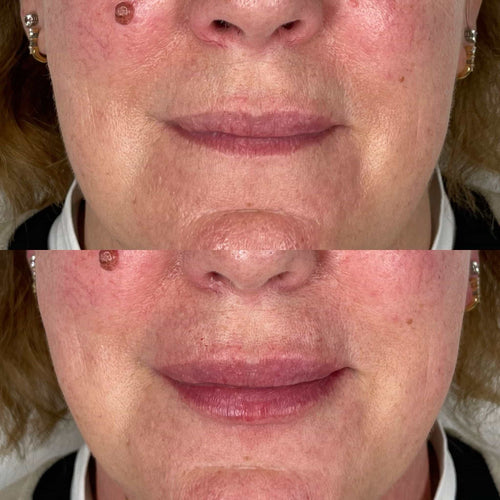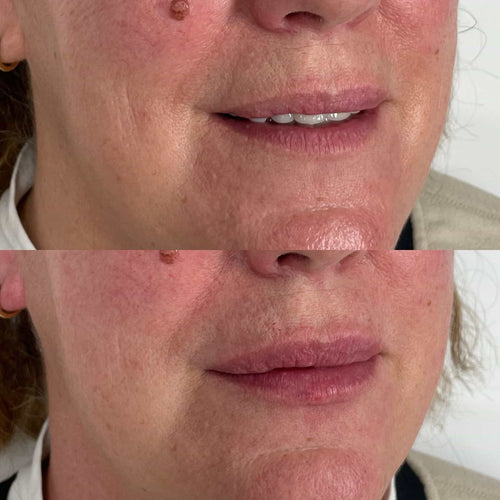Reserve Your Dermal Filler Appointment with Dr. Laura Geige Now
Botox’s Evolving Impact
The Changing Landscape of Facial Aging
Botox, a neurotoxin derived from bacteria, has revolutionized the aesthetic landscape since its introduction two decades ago. Initially marketed for treating medical conditions like excessive sweating and muscle spasms, it quickly gained popularity as an anti-aging treatment, capable of temporarily paralyzing facial muscles that cause wrinkles.
Over the past 20 years, Botox has gone beyond smoothing forehead lines and crow’s feet to become a versatile tool in addressing various aesthetic concerns. It can now be used to elevate eyebrows, define jawlines, slim necks, and even minimize gummy smiles.
This widespread adoption has profoundly changed the **_landscape of facial aging_.** While once viewed as an inevitable process culminating in wrinkles and sagging skin, aging is now increasingly perceived as something that can be managed, delayed, or even reversed to a significant extent.
The *increasingly popular* use of Botox has sparked both praise and criticism. Supporters applaud its ability to boost confidence, empower individuals to control their appearance, and offer a non-invasive alternative to surgical procedures. However, critics raise concerns about the potential for overreliance on injectables, the risk of developing an unnatural or “frozen” appearance, and the societal pressures it may exert on individuals to conform to certain beauty standards.
Looking ahead, the *future of Botox* is likely to be shaped by advancements in technology, evolving consumer preferences, and ongoing ethical discussions. Researchers are exploring new formulations and applications, such as biodegradable fillers and targeted muscle relaxants. Meanwhile, a growing movement advocates for embracing natural aging and challenging unrealistic beauty ideals.
In conclusion, Botox has undeniably transformed the way we approach facial aging. Its accessibility, effectiveness, and versatility have made it a cultural phenomenon, but its impact extends far beyond aesthetics, raising important questions about self-perception, societal expectations, and the ever-evolving definition of beauty.
Arrange a Dermal Filler Appointment with Dr. Laura Geige
Evolving Techniques and Expectations
Botox, the neurotoxin derived from Clostridium botulinum bacteria, has become a ubiquitous presence in the world of cosmetic procedures since its introduction two decades ago. Its initial use as a treatment for strabismus and blepharospasm gradually expanded to encompass facial aesthetics, with the aim of smoothing wrinkles and achieving a youthful appearance.
Over the years, Botox’s impact has evolved dramatically, exceeding its initial purpose.
It has become a cornerstone of non-surgical rejuvenation, shaping perceptions of beauty and influencing cultural norms around aging.
This evolution is reflected in three key areas:

* **Evolving Techniques:**

- From Static to Dynamic: Initially, Botox was primarily used to freeze static wrinkles – those that appear at rest. However, the focus has shifted towards dynamic wrinkle reduction, targeting wrinkles caused by muscle movement (e.g., frown lines). This involves injecting smaller doses in specific areas to soften expressions without completely paralyzing facial muscles.
- Microdosing: A refined technique involving the administration of very small doses of Botox to achieve subtle results and maintain a natural appearance. It allows for targeted muscle relaxation while preserving expressiveness.
- Combination Therapies: Botox is increasingly integrated with other procedures, such as fillers, laser treatments, and microneedling, to address multiple signs of aging simultaneously.
* **Expanding Applications:**
- Beyond the Face: While facial rejuvenation remains prevalent, Botox is now used for a broader range of medical and aesthetic purposes. This includes treating migraines, excessive sweating (hyperhidrosis), muscle spasms, neck pain, and even gummy smiles.
- Non-Invasive Body Contouring: Emerging techniques utilize Botox to temporarily reduce muscle bulk in areas such as the abdomen, thighs, and arms, promoting a more sculpted silhouette.
* **Evolving Expectations:**
- Natural Enhancement: The focus has shifted from achieving a completely “frozen” look to subtle enhancements that maintain natural beauty. Patients seek results that appear refreshed and rejuvenated, not drastically altered.
- Long-Term Solutions:**
Botox is increasingly viewed as part of a preventative skincare regimen, with regular treatments used to delay the onset of deeper wrinkles.
The future of Botox promises continued innovation and refinement. Research explores new applications, including personalized dosing strategies based on individual anatomy and genetics. As technology advances, we can anticipate even more precise, effective, and aesthetically pleasing results.
Navigating Long-Term Botox Use
Addressing Potential Concerns
Navigating long-term Botox use involves understanding both its potential benefits and risks, as well as developing a personalized approach that considers individual needs and goals.
While Botox is generally considered safe when administered by qualified professionals, prolonged use can raise certain concerns:
- Antibody Development:
- Loss of Facial Muscle Function:
- Migration:
- Dependence:**
- Underlying Medical Conditions:
Repeated exposure to Botox can trigger the body to produce antibodies that may neutralize its effects. This phenomenon, known as antibody-mediated resistance, can require higher doses or alternative treatments.
Over time, continuous Botox injections may weaken facial muscles, leading to a “frozen” or immobile appearance. It’s crucial to follow recommended injection schedules and dosages to minimize this risk.
Botox can sometimes migrate to surrounding areas, causing unintended muscle paralysis. Proper injection techniques and understanding facial anatomy are essential for preventing this.
Some individuals may develop a reliance on Botox to maintain their desired appearance, leading to a cycle of repeated injections.
Botox use should be carefully considered in individuals with certain medical conditions, such as muscle disorders or allergies.
To mitigate potential concerns associated with long-term Botox use:
*
Seek a qualified and experienced injector:
Choose a practitioner who is board-certified and has a thorough understanding of facial anatomy and Botox injections.
*
Discuss your goals and concerns openly:
Communicate your expectations, desired outcomes, and any past experiences with Botox to ensure personalized treatment.
*
Follow recommended injection schedules and dosages:
Adhere to the injector’s guidelines to minimize risks and maintain optimal results.
*
**Regularly monitor your progress:**
Attend follow-up appointments to assess results, address any concerns, and adjust treatment plans as needed.
*
Explore alternative treatments:
Consider options such as dermal fillers or facial exercises to complement Botox injections and promote a balanced approach to aesthetic rejuvenation.
Remember that long-term Botox use should be approached thoughtfully, with open communication between the patient and injector. A personalized strategy that balances desired outcomes with potential risks can help individuals achieve their aesthetic goals safely and effectively over time.
Long-Term Effects on Facial Muscles
Botox, a neurotoxin derived from botulinum toxin type A, is primarily used to temporarily paralyze muscles responsible for wrinkles. While effective for smoothing skin and reducing the appearance of fine lines, long-term use can raise concerns about potential effects on facial muscles.
Here’s what you should know about navigating long-term Botox use and its potential impact on facial muscles:
Book a Dermal Filler Session with Dr. Laura Geige at It’s Me and You Clinic
-
Muscle Weakening: Over time, repeated Botox injections into specific muscles can lead to muscle atrophy (weakening). This occurs because the toxin temporarily blocks nerve signals to the muscles, preventing them from contracting. While this effect is temporary with each injection, prolonged use may result in a decrease in muscle mass and strength over years.
-
Depleted Facial Expressions: Facial expressions rely on the coordinated contractions of multiple muscles. Weakening these muscles through prolonged Botox use can lead to a less expressive face, potentially making it appear more static or “frozen.”
-
Unpredictable Results: The way individuals respond to Botox varies widely. Some people may experience minimal muscle weakening even with years of use, while others might see more pronounced effects. This unpredictability makes it crucial to have a thorough discussion with your doctor about expectations and potential risks.
-
Rebounding Effect: When Botox wears off, the treated muscles may experience a “rebound” effect, becoming stronger than they were before treatment. This rebound can sometimes result in wrinkles appearing deeper or more pronounced than before Botox use.
It’s essential to emphasize that not everyone who uses Botox long-term will experience these negative effects. Many individuals maintain a youthful appearance with regular injections and minimal muscle weakening. However, it’s crucial to be aware of the potential risks and have realistic expectations.
The decision to use Botox long-term should be made in consultation with a qualified medical professional who can assess individual needs, skin type, muscle structure, and desired outcomes.
Create Cocktails at Home K Aesthetics Studio The First Come First Served Apples and Pears Co.
- Traptox Aka Trapezius Botox Treatment Near Thames Ditton, Surrey - January 5, 2025
- Skin Pen Microneedling Near Surbiton, Surrey - January 3, 2025
- Skin Pen Microneedling Near East Molesey, Surrey - January 2, 2025
